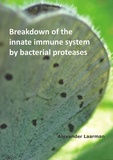Breakdown of the innate immune system by bacterial proteases

Laarman, Alexander
- Promoter:
- Prof.dr. J.A.G. (Jos) van Strijp
- Co-promoter:
- Dr. S.H.M. (Suzan) Rooijakkers
- Research group:
- Rooijakkers , Strijp
- Date:
- October 4, 2011
- Time:
- 10:30 h
Summary
Bacteria have developed many strategies to circumvent our immune system to survive and colonize human tissues. One of these strategies is by secreting proteases that specifically target the innate immune system. Aureolysin is a metalloprotease from Staphylococcus aureus which target the main component of the complement system C3. By degrading C3, S. aureus inhibits the complement cascade thereby preventing all effector functions, such complement activation, chemotaxis of phagocytes, phagocytosis and killing. Another complement inhibiting molecule is the alkaline protease (AprA) from Pseudomonas aeruginosa. AprA specifically targets C2. C2 is a crucial factor for the activation of the classical and lectin pathway of complement. By producing AprA, P. aeruginosa inhibits these two pathways and all mediated effector functions. Next to the complement system, the attraction and activation of phagocytes to the site of infection is crucial for the killing of bacteria. Staphopain A, a cysteine protease secreted by S. aureus inhibits these steps by cleaving of the CXC chemokine receptor 2 (CXCR2). CXCR2 recognizes many chemokines including IL-8, which is important for the chemotaxis and activation of neutrophils.
Overall it shows that bacteria modulate our innate immune system by secreting proteases that specifically target key molecules in this system thereby preventing immune attacks and increasing bacterial survival.